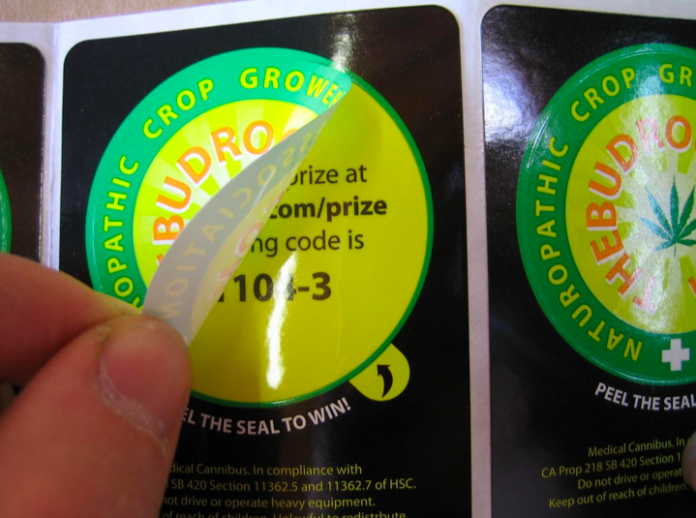Nowadays, label innovation is influenced by marketing research, and one of the most effective ways consumers can be attracted to a product involves presenting its essential features in a colorful and minimalist fashion. But there are situations where more information is needed or where the manufacturer may have specific promotions that it wants to publicize, which may affect the general look of the label. A solution is required, and that, in many cases, can come via piggyback labels.
What are they? They are a type of label that comes in two layers, which can be peeled back to show additional information about the product being sold. Also known as peel-back labels, they are generally used to provide information about the intended usage of the purchased products or to share promotional messages. Staying up with the trends, these labels are also used in recent years to display QR codes that redirect the client to selected web pages. But you are a person who wants to be well-informed. So, in the next few minutes, we will discuss the factors you should consider when choosing piggyback labels for your products, and we will also list some considerations related to battery labels.
Use an Innovative Design that Makes Your Product Stand Out
More than 72% of Americans say that a product’s packaging design can affect their decision to purchase it or not. And one of the most important aspects determining the success of your product is its custom labeling. Are you, for example, the owner of a company that sells chocolate sweets? Then it is possible to attract your clients through various and constant promotions, and piggyback labels can help you. As the name suggests, peel-back labels are stuck on top of each other, and when removed, they can provide additional information about the product or the special offers presented.
Offers can come in the form of barcodes or QR codes. Peel-back labels can also present nutritional or usage information about your product. But there are a few things you need to consider. Firstly, the shape of the two labels must be identical, and the adhesive used must be suitable for peel-back labeling. The last thing you would want is to use glue that cannot be removed without damaging the packaging. Secondly, you need to consider the materials used. While a regular paper label applied on a silicone layer may be an option in the case of traditional packaging, in the case of peel-back labels, you need more flexibility, so the material used will probably be BOPP.
What Are the Uses of Peel-Back Labels?
Piggyback labels are, first and foremost, an ideal way to cram extra information into a minimalist package. Do you market any chemical products that require additional information on proper usage? Then a peel-back label could hide warnings or info about the product’s chemical components. But the uses of peel-back labels don’t stop there. Peel-back labels are ideal for parcels sent via couriers, as they can hide identification numbers or tracking codes. They can also be used for postcards, as sorting tools in local depots, or in the healthcare or banking sector. Peel-back labels can also be customized and used as easy-to-respond wedding cards, or they can be manufactured to allow multilingual information on a purchased product.
More than 30% of businesses reported an increase in their annual revenue once the quality of the product packaging improved. Proper labeling can result in higher ROI, and appropriate labels can be necessary to increase your brand image. Peel-back labels can be used to offer free samples to consumers, provide a link to your online catalog, or serve as a way to follow your state’s regulatory requirements. A peel-back label may hide the expiration date of the product being offered, and if we are talking about a food item, it could show the product’s nutritional value. Peel-back labels are, above all else, versatile and can be used in a wide range of industries for many use cases.
What to Know About Battery Labels?
Due to the corrosive properties of batteries, and their use in potentially harsh environments, battery labels must be durable and able to withstand conditions not found in other labels. The chemicals in the label manufacturing must be non-reactive and water-resistant, so battery labels are generally constructed from polyester. In addition, these labels must concisely present the information required by regulators like the DOT. But what should they look like?
First of all, battery labels must provide information about the chemical properties of the battery. Wet cell batteries, for example, are used in motor vehicles and are constructed from six separate cells filled with sulphuric acid. This makes them potentially hazardous, so ample safety warnings must accompany them. And the same goes for lithium-based batteries or zinc air batteries. A battery’s label must also contain information about its voltage, specifications on how the battery can be recycled, and accurate placement of marketing information required by the manufacturing company.
Make Your Product Visible
Whether talking about piggyback labels for the food industry or professional battery labels, the right design and information presented can mean the success or failure of your product. Labels have become one of the most effective ways to differentiate products for buyers. Given the increasing competition in national markets, and the abundance of options for shoppers, marketers need to think outside the box to attract their target audience’s attention, which is why many of them turn to agency professionals with experience in creating custom labels.
Why not handle label creation in-house? Because companies specializing in label production have the expertise and tools to create a label that brings out the features of your brand. Companies in this field can help you with DYI and custom labels and benefit from all the technologies needed to create stickers that will stand the test of time. In addition, hiring professionals to design your product label can free up your staff’s time and allow them to continue innovating in your field.































